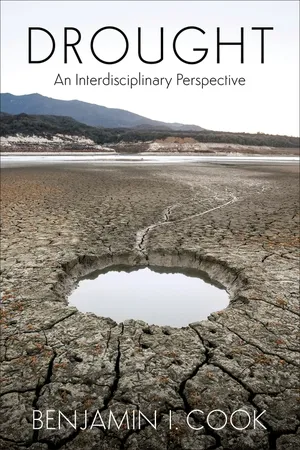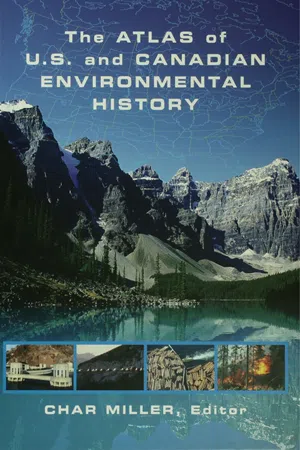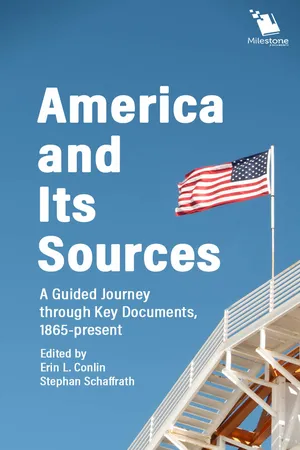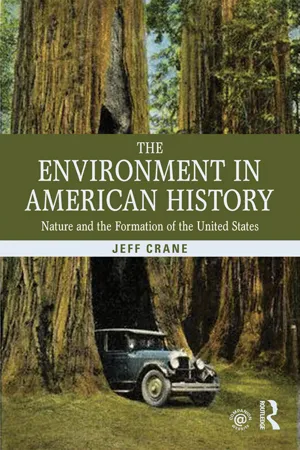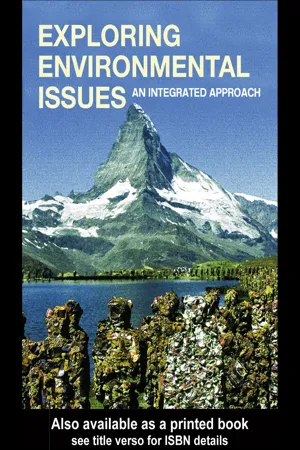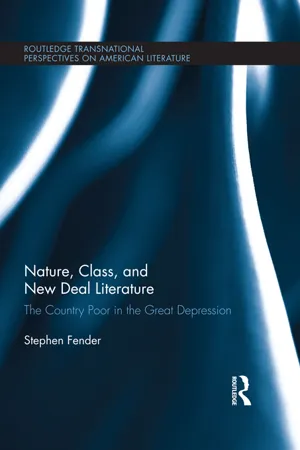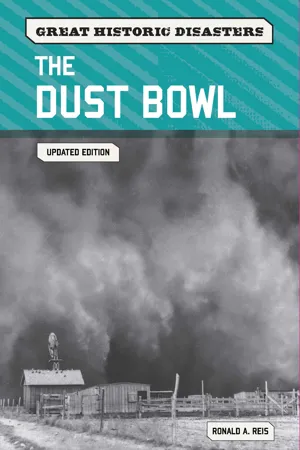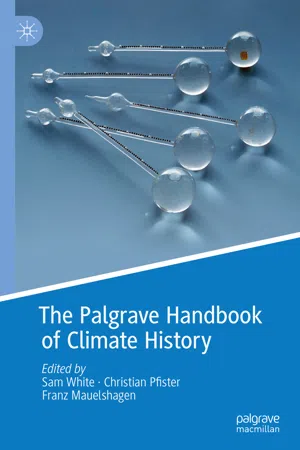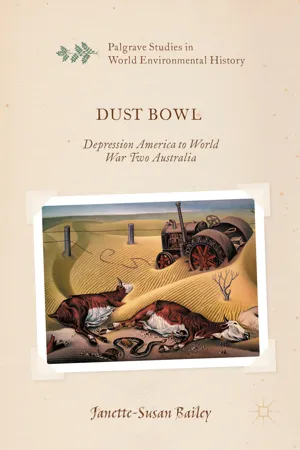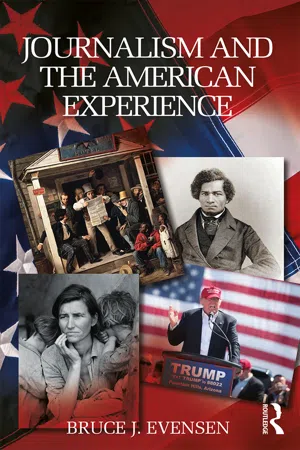History
Dust Bowl
The Dust Bowl was a period of severe dust storms that greatly damaged the ecology and agriculture of the American and Canadian prairies during the 1930s. It was caused by a combination of drought, poor farming practices, and high winds, leading to widespread soil erosion and economic hardship for many farmers. The Dust Bowl had a significant impact on the environment and the economy of the affected regions.
Written by Perlego with AI-assistance
Related key terms
Related key terms
1 of 4
Related key terms
1 of 3
12 Key excerpts on "Dust Bowl"
- eBook - ePub
Drought
An Interdisciplinary Perspective
- Ben Cook(Author)
- 2019(Publication Date)
- Columbia University Press(Publisher)
SIX Case Studies The Dust Bowl and Sahel DroughtsA mong the many persistent droughts that occurred during the 20th century, two events are notable for their intensity, their impacts, and the interest they generated in the scientific community. The first is the Dust Bowl of the 1930s, a nearly decadal long drought that afflicted much of the central plains in North America. Combined with a major economic depression and poor land-use practices, this drought became one of the worst natural disasters in U.S. history, resulting in historically high levels of land degradation, human migration, and dust storm activity. The second is a persistent drought that affected the Sahel region of West Africa from the late 1960s through the early 1990s. This multidecadal period of below-average rainfall ravaged ecosystems and subsistence farming communities in the region, inspiring new schools of thought and investigations into drought, desertification, and climate change. Here, we review these major droughts, discussing their causes and impacts (including the role of human activities) and some of the major lessons learned from studying these events.The Dust BowlThe term Dust Bowl was coined in 1935 by Robert E. Geiger after Black Sunday, a massive dust storm that blew across the Oklahoma Panhandle on April 14, 1935. Geiger, an Associated Press reporter, experienced the storm in Boise City, Oklahoma, and afterward would write, “Three little words achingly familiar on a Western farmer’s tongue rule life in the Dust Bowl of the continent—if it rains” (Worster, 2004). Originally, the term was used to refer to the specific area of the southern plains near the Oklahoma and Texas Panhandles that was the center of the most intense dust storm activity and wind erosion during the drought. Later its use would expand, and Dust Bowl - Char Miller(Author)
- 2003(Publication Date)
- Routledge(Publisher)
While granting greater mobility to some, the new superhighways and expressways cut through and often isolated or destroyed poor ncighborh(x>ds, intensifying class and racial segregation; as they united disparate parts of Canada and the United States, and provided greater access to wild spaces, they also bulldozed through deserts, meadows, and wetlands. In helping to build the glittering, steel-and-glass skylines of Toronto and Vancouver, Houston and Los Angeles, the car also wrapped them in a smoggy haze. During this Atomic Age, North Americans were faced with a series of difficult choices.—Char MillerThe Dust Bowl in the Great PlainsThe “Dust Bowl” was the term coined for the nearly ten years of drought, dust storms, and high temperatures that the people of the Great Plains endured in the 1930s. Although all of the Great Plains experienced drought during that decade, the worst of the drought and dirt storms were concentrated in the Southern Plains, in an area including parts of Kansas, Oklahoma, Texas, New Mexico, and Colorado. This environmental crisis significantly affected the land and the people of the Southern Plains.Causes.The Dust Bowl had a number of causes. The area is semiarid, receiving little rain—generally less than 20 inches (0.5 meter) yearly. The area’s soils are light and easily blown by the high spring winds. During the 1930s, the area experienced extreme drought conditions, which were exacerbated by some of the highest summer temperatures on record. In southwestern Kansas, for example, rainfall for the decade averaged 20 percent below normal and, in some years, 50 percent below normal. In the summer of 1934, residents endured fifty days of temperatures at or above 100°F (38°C). The earth, normally dry, was baked and blown into a fine powder.Drought and high temperatures alone were a recipe for disaster, but farming practices of the previous two decades made the situation considerably worse. During the 1910s and 1920s, farmers had plowed many acres of land previously left fallow or devoted to pasture for cattle. In 1890, only 5,762 farms and ranches were located in areas that would be affected by the Dust Bowl in Kansas, Colorado, and Texas. By 1910, this number had nearly doubled to 11,422. Most farmers developed their land without attention to conservation practices like crop rotation and terracing and plowed to the very edges of their property in their eagerness to make a profit. Land that was already dry and sandy was no longer anchored by native grasses, making it particularly susceptible to wind erosion. This resulted in day after day of dirt storms, ranging from a simple haze of dirt in the air to rolling black storms that blotted out the Sun. During one particularly bad dust storm in 1935, geologists in Wichita, Kansas, estimated that 5 million tons of dust were suspended over the city. Breathing this fine dirt led to respiratory ailments, for example, dust pneumonia in humans, and caused the deaths of untold numbers of cattle and other livestock.- eBook - ePub
America and Its Sources
A Guided Journey through Key Documents, 1865-present
- Erin L. Conlin, Stephan Schaffrath, Erin L. Conlin, Stephan Schaffrath, Erin L. Conlin, Stephan Schaffrath(Authors)
- 2019(Publication Date)
- Milestone Documents(Publisher)
6.1 The Great DepressionOverviewAs Unit 5 concluded, we saw that while some Americans in the 1920s were reaping the benefits of a booming, largely unregulated economy, others were already suffering economic woes. Farmers entered a depression in the 1920s, and by the 1930s many were in the throes of economic ruin. Not only did they face problems from collapsing food prices and high loan repayments, but also in the 1930s the environment was also working against them.In the Southern Plains region of the American West (covering portions of New Mexico, Colorado, Texas, Oklahoma, and Kansas), a severe drought and decades of poor policy decisions and terrible farming practices resulted in a farming and environmental crisis known as the Dust Bowl. Since the Civil War, the government had granted settlers moving west large swaths of prairie land if they worked to make the land “productive.” Settlers and land speculators—individuals purchasing land hoping to get rich quickly—soon began clearing the land. Farming required tearing up native prairie grasses to make room for agricultural crops. The semi-arid region could not sustain this type of agricultural development. Prairie grass had long played a key role in the ecosystem, holding the sandy soil down and preventing it from drying out and blowing away. After years of farming, the ground no longer had enough natural habitat to hold the soil in place. When a severe drought began in 1931, farmers had no idea of the monster they had created. Winds whipped through the regions, sucking dust into the air and creating “black blizzards”—deadly dust storms that destroyed farms and suffocated people and livestock. So-called dust pneumonia killed many. People’s and animals’ lungs filled with fine particles of sand, making it impossible to breathe. Eventually their lungs gave out and they died. The drought lasted eight years. - eBook - ePub
Natural Visions
The Power of Images in American Environmental Reform
- Finis Dunaway(Author)
- 2016(Publication Date)
- University of Chicago Press(Publisher)
16Advocates of permanent agriculture refused to accept the idea that the dust storms and floods of the 1930s were “natural” disasters. Instead, they viewed these events as human-created calamities, legacies of a myopic, exploitative relationship with the earth. Tugwell’s comment about the “mess of individualistic pottage” illustrates the target of their critique. They blamed the Dust Bowl not on the drought but on the individualism of Americans, on the careless ways that the nation used the land. According to these officials, the ecological problems of the 1930s suggested an inversion of the familiar narrative of frontier progress: rather than civilizing a wilderness, Americans had created chaos, turning the grasslands into a barren desert and the rivers into angry, destructive waters.17While government officials emphasized human culpability, visual imagery—particularly the newsreels—portrayed the dust storms as entirely natural in origin. Newsreels frequently included stories of natural disasters—from typhoons in Japan to hurricanes in Texas. When they began to cover the environmental destruction on the Great Plains, the newsreels made the Dust Bowl appear equivalent to these events. Like a cyclone or a tidal wave, dust storms resulted from the capricious behavior of nature.Newsreels blamed the weather—especially the long drought of the 1930s—for all that was wrong on the Plains. An issue of Universal Newsreels released in June 1934 features images of a deserted home in South Dakota—a farm where a tractor has been left behind, where an orchard has been ruined by the lashings of sand and wind. “The prolonged drought in the middle west,” the narrator explains, “has brought another great catastrophe with it—dust and sand storms—blistering, withering, wind-swept clouds of finely powdered dirt that is suffocating to man and beast and that covers all vegetation, transforming farms into barren dust piles and sand dunes.” Like New Deal rhetoric, this newsreel presents nature as a sublime force that dominates and overpowers human society. Yet it does not suggest a larger context, a sense of the history that lay behind the current crisis. It describes the “prolonged drought” as the sole cause of the “great catastrophe.” And if the weather was to blame, then perhaps the end was not imminent. After all, the weather is fickle; it could change at anytime.18 - eBook - ePub
The Environment in American History
Nature and the Formation of the United States
- Jeff Crane(Author)
- 2014(Publication Date)
- Routledge(Publisher)
The Dust Bowl was not simply a natural disaster in the sense that most Americans think of it. It was created by trying to apply the model of industrialized capitalism developed in a eastern, well-watered agriculture to a drier landscape that experiences cyclical droughts. Stripping land of all its cover left it vulnerable when the skies dried up. Those dust storms were something to behold and created terror and death for residents of the region. Varying in color based on the origins of the storm, brown, red, black, and yellow walls of dust would bear down on communities with little warning, sometimes catching farmers still on their tractors or tending livestock. Families were trapped on roads and livestock caught outside; many were suffocated by the dust. The suspended dirt in the air was so heavy at times that people couldn’t see their hands in front of their faces. When the storm passed crops would be covered in drifting dust, several feet deep in places, killing the plants that promised a future. The top soil was stripped away in many places, leaving only hardpan underneath, soil that was difficult to work and low in fertility. Deaths did not stop once the storms passed. Many children died of pneumonia worsened by the dust in their lungs, and animals expired from respiratory problems arising from dirt-filled lungs and from starvation. Storms rolled through year after year, and it was only a serendipitous moment that caught the official attention of the federal government in Washington, D.C. The introduction of a bill for relief from the Dust storms occurred as one of the major storms arrived on the East Coast, dropping Great Plains soil on congressmen who had ignored the crisis to this point. Once fully aware of the environmental and economic problems in the southern Great Plains, the federal government applied its money, labor, and ingenuity to the fight to save the soil and the communities dependent on that soil by means of 1935 drought relief legislation.Figure 9.3 This image of a dust storm approaching and enveloping a town was a regular occurrence for people of the Great Plains during the Dust Bowl years. The storms dumped dust, killing livestock and crops and creating a mess for people to clean up. Sometimes people became disoriented and got trapped and died in the storms as well. Courtesy of the Western History Collection, University of Oklahoma Libraries, Snowden Dwight Flora Collection, Flora 77.While Dust Bowl sufferers turned to their own limited resources to persist until the rains returned, the federal government provided assistance in numerous ways, trying to reform ranchers’ and farmers’ destructive practices. Contrary to rural and western mythology of independence from government assistance, southern Plains farmers demanded help from the government. According to Worster,It may seem ironic that wheat farmers in Kansas, who had become so fully a part of the economic system, would want protection from the penalties for failure. But the experiences of overproduction and dust storms were sufficiently traumatic to produce a revised maxim for business farming in the decade: do not interfere with us when we are making money but rescue us when we are going bankrupt.9Figure 9.4 - eBook - ePub
Exploring Environmental Issues
An Integrated Approach
- David D. Kemp(Author)
- 2004(Publication Date)
- Routledge(Publisher)
The image of the Great American Desert had paled, and the settlers farmed just as they had done east of the Mississippi or in the Mid-west, ploughing up the prairie to sow wheat or corn. By the 1880s and 1890s the moist spell had come to an end, and drought once again ravaged the land (Smith 1920), ruining many settlers and forcing them to abandon their farms. As many as half the settlers in Nebraska and Kansas left their farms at that time (Ludlum 1971), like the earlier inhabitants, seeking relief in migration, in this case back to the more humid east. Some of those who stayed experimented with dry farming, while others allowed the land to revert to its natural state, and used it as grazing for cattle, a use to which it was probably much more suited in the first place. The lessons of the drought had not been learned well, however. By the 1920s the rains seemed to have returned to stay and a new generation of farmers moved in. Lured by high wheat prices, they turned most of the Plains over to the plough, seemingly unaware of the previous drought or unconcerned about it. Crops were good as long as precipitation remained above normal, but by 1931 the good years were over and throughout the remainder of the decade the Plains were plagued by dust storms which carried away tens of millions of tonnes of topsoil. In combination with the rundown economic state of the country and the world at that time (a period commonly known as the Depression), these conditions created such disruption of the agricultural and social fabric of the region that the effects have reverberated down through the decades, and the Dustbowl remains the benchmark against which all subsequent droughts have been measured. The only possible response for many of the drought victims of the 1930s was migration, as it had been in the past - eBook - ePub
Screening America
United States History through Film since 1900
- James Lorence(Author)
- 2016(Publication Date)
- Routledge(Publisher)
Overuse of the soil, including the cultivation of submarginal lands, made the swirling dust storms of the mid-1930s brutal in their impact. In their wake, once-productive acreages now assumed a desertlike appearance. A further complication stemmed from the combination of increased mechanization on the farm, which displaced a large number of marginal farmers, and the shortage of capital available to small producers. The problem thus created was magnified by the unintended effects of New Deal agricultural policies that encouraged acreage restriction and caused landowners to withdraw tenant and sharecropper lands from production. 1 Landless and homeless, the rural dispossessed joined a mass migration that enlarged the California population and produced social tensions as newcomers and natives clashed in the fertile valleys of the West. By the mid-1930s, the Roosevelt Administration had already turned its attention to the economic and social problems of the Dust Bowl, including the human casualties. In 1935, for example, the progressive Resettlement Administration (RA) decided to produce a film intended to call attention to the errors that had created this ecological problem. Arguably the New Deal’s most radical agency, the RA, along with its director, the agricultural economist Rexford Tugwell, asked film critic Pare Lorentz to plan, shoot, cut, and finish a documentary “film of merit” focusing on the Dust Bowl crisis. In the motion picture that resulted, The Plow That Broke the Plains (1936), Lorentz and his crew succeeded in capturing the root causes of the Depression era environmental problem in the Southwest, as well as the tragic social dislocation and family disruption that followed. Controversial from the start, the film was criticized as New Deal propaganda, though Lorentz insisted that his concern had always been to advance the film as an art form while presenting an important social message - eBook - ePub
Nature, Class, and New Deal Literature
The Country Poor in the Great Depression
- Stephen Fender(Author)
- 2011(Publication Date)
- Routledge(Publisher)
Again, contrary to the popular story, the rush to California did not peak during the Depression. Rumors of new opportunities and a temperate climate, later reinforced by the glamour of the movies, had been attracting Southwesterners to the state since the second decade of the century. Between 1910 and 1930 more migrants arrived—albeit with more skills and savings than the Okies—than during the whole of the Depression. In the 1940s California war industries like shipbuilding and aircraft manufacture pulled in nearly twice the numbers of those supposedly blown off their farms in the Dust Bowl.That phrase “Dust Bowl” itself, though certainly based on horrific concrete events, came to stand in as misleading shorthand for the whole migrant experience. For people in Texas, Arkansas and Oklahoma the mid-30s drought and economic hardship were real enough, but the truly devastating dust storms were restricted mainly to the western half of Kansas, the southeastern corner of Colorado and the eastern border of New Mexico; they brushed past Texas and Oklahoma only at the panhandles where the two states meet, and missed Arkansas by four hundred miles.2 The process by which that dust, the most striking image of a widely perceived natural catastrophe, came to displace the social and economic causes of the Okie migration in the popular consciousness and memory, is the story of this chapter.What the historians do accept, though it remains much less prominent in the popular memory, is that the migrants were unprepared for the kind of agriculture they found in California. Farms in the Central Valley were huge, involved in specialized agribusiness before that term was coined. Instead of being settled after the Jeffersonian ideal of small family homesteads, California farms had evolved top-down from large estates that had originally been Mexican land grants. They were big and commercial, too, because of their need for water: away from the rivers running south and north down its center, most of the Central Valley was desert. This meant irrigation, and irrigation needed plenty of capital. The scale of the operation also tended toward specialization: at first in wheat, until that market collapsed in the Depression; then in fruit and vegetables, as the railroads developed efficient “reefers,” insulated box cars refrigerated by stacks of ice at both ends, to carry chilled produce across the continent to eastern markets. - eBook - ePub
- Ronald Reis(Author)
- 2021(Publication Date)
- Chelsea House(Publisher)
For many, the drought and dust storms spreading across their lands were the portent of Judgment Day. "I think the drought was sent to us from God because of the wicked and perverse ways of the people existing today," voiced a Wheeler, Texas, resident. "I go to church more for spiritual guidance and strength. My belief is that God is punishing us for the way we live."Some felt that farmers just had to accept their adversity without complaint. Writing to a friend in Oklahoma, Texan Evelyn Harris declared, "They forget that the Lord giveth and the Lord taketh away, and that we, as farmers, are powerless to do anything about it either way [when] some other act of God destroys our crops."Known as "Black Sunday," the biggest dust storm of the Dirty Thirties struck soundlessly and forcefully, surprising many people as they went to church, enjoyed a Sunday drive, or embarked on a rabbit drive. Dust blackened the sky and blocked out the sun, as surfaces everywhere, like this sink, became covered in dirt.Source: © Getty Images. Time&Life Pictures.The Great Plow Down
Not everyone believed farmers were powerless, unable to effect change. "Big" Hugh Bennett, the "doctor of dirt" and "father of soil conservation," felt that, with the right approach and correct action, many farm communities in the Dust Bowl could be saved and rejuvenated.With the election of Democrat Franklin Delano Roosevelt to the White House in 1933, the federal government's approach to dealing with the problems of the Great Depression moved in a dramatic new direction. It was the government's responsibility, the New Deal president believed, to aid those individuals and groups in need—a direct departure from the Hoover administration's laissez-faire, or hands-off, approach. Relief, recovery, and reform, Roosevelt's "three Rs," would thereafter guide federal farm policy.On May 12, 1933, the president put his signature on the Agricultural Adjustment Act (AAA). Its main purpose was to do something that at first seemed, if not bizarre, contrary to common sense. The AAA would pay farmers not to grow crops or raise animals for slaughter. By either not planting or destroying what had been planted, it was hoped that supply would fall, demand would rise, and farm commodity prices would climb. With more money in their pockets, farmers would start spending, thus raising the economic level of the towns and rural communities that served the farm sector. - eBook - ePub
- Sam White, Christian Pfister, Franz Mauelshagen, Sam White, Christian Pfister, Franz Mauelshagen, Sam White, Christian Pfister, Franz Mauelshagen(Authors)
- 2018(Publication Date)
- Palgrave Macmillan(Publisher)
This has been particularly true in semiarid regions, because as Michael Glantz and colleagues have argued, “drought follows the plow”: that is, temporarily moist conditions permitting an expansion of arable land or pasture will sooner or later turn dry again. For instance, the American Dust Bowl of the 1930s was only one of many recurring droughts to hit the Great Plains in recent centuries. What made this drought a human disaster was the extension of wheat cultivation during the preceding decade, which probably aggravated drought conditions and erosion and left more farmers vulnerable to crop failure during the hard economic times of the Great Depression. 50 Other Dust Bowl events and agricultural failures in semiarid regions of Australia, Canada, the Soviet Union, and the African Sahel during the twentieth century followed a similar pattern. 51 In the case of the Sahel famines of the 1970s and 1980s, anthropogenic aerosol pollution may have aggravated regional drought conditions (see Chap. 26). Furthermore, parts of the world during the twentieth century remained vulnerable to ENSO fluctuations and their associated weather patterns, particularly in Latin America, the Pacific, and South-East Asia (see Chap. 26). Accelerating global warming since the 1980s has raised the possibility of more abrupt or extreme climatic change, beyond the adaptive capacity of the current food system. On the one hand, it seems unlikely that climate change will so reduce food production as to threaten global food shortages in the next few decades. Food supplies have risen faster than population since the early twentieth century. The considerable share of global food production either wasted or devoted to beef production should leave significant spare capacity for human food supplies - eBook - ePub
Dust Bowl
Depression America to World War Two Australia
- Janette-Susan Bailey(Author)
- 2016(Publication Date)
- Palgrave Macmillan(Publisher)
91Hogue’s Drouth Stricken Area shows an abandoned farm engulfed by endless waves of drift sand (Fig. 4.2 ). All signs of civilization are broken or lie buried under desert sands. A windmill, now useless, stands broken. By the windmill, a bull so important to civilization, has been left behind and starving, now searches for water in a tank filled with sand. A vulture waits—he will be the only one left soon. Dust Bowl (1933) also featured (see newspaper image, Fig. 4.7 ). Dust Bowl shows destructive tractor tire tracks and fence-lines in the foreground, a homestead in the background of a desert expanse. The whole image in its brilliant orange and red tones is framed by an oppressive heat and a sense of loss the viewer can feel.A scorching sunset on the horizon frames this waterless place with a heavy sense of oppressive heat. Hogue provided no desert gardens. There are no happy endings in his painting, nor in his commentary on the pumping of water from the region’s great aquifer. Instead, he warned:the Ogallala aquifer is the largest in the world. But since millions of acres of wheat are irrigated from it, it will soon be dry for several thousand years leaving Llano Estacado a desert.92Women and Human Erosion: Ma Joad, Woman of the High Plains , and Migrant Mother
The idea of a permanent desert decline is also clear in gendered Dust Bowl narratives. They reflect that traditional and paradoxical set of beliefs about deserts, women, progress, and civilization—and the connections in between. Here, the idea of “the family as the traditional unit of our civilization,” was expressed in the image of the housewife and mother.93Conventional images showed her as orderly, slim but healthy, fashionable and attractive, clean and tidy, and almost always operating in and closely around the domestic sphere. However, human erosion narratives took her away from the homestead and into the wilderness. To dramatize the idea of a soil/human interrelationship, they drew on the Judeo–Christian idea of “desert” as a “deserted place or wilderness.”94Photographers such as Dorothea Lange expressed this by capturing images of depression-era poverty, but Lange remained wary of Stryker’s ideas, conceived of in Washington, DC, so far away from the influence of her subjects in the West. Featuring in Lange and Taylor’s An American Exodus, Woman of the High Plains (1938) is one of those images but the subject is not a refugee. In this image, the “wilderness” of the Dust Bowl is the place into which she has been cast. Impoverished by it, she struggles to survive in the Texas Panhandle. The caption, quoted from the subject, Nettie Featherston reads, “when you die you’re dead, that’s all.”95Unlike Woman of the High Plains, in many of Lange’s photographs, women are often no longer in the Dust Bowl and have become refugees. On the road or in migrant camps, they symbolize civilization, once the pioneering conqueror of deserts and wastelands, expelled by the very desert it has created.96 - eBook - ePub
- Bruce J. Evensen(Author)
- 2018(Publication Date)
- Routledge(Publisher)
Ochiltree County Herald reported Texas had “nothing like it on record.”Associated Press reporter Robert Geiger, overtaken by the storm outside Boise City, Oklahoma, wrote of the “Dust Bowl” in describing Black Sunday. The term seemed to capture the pitiful plight of the Plains. Bennett seized on this moment to implore lawmakers to do something “to avoid calamity in the rural West.” The Washington Post reported that government office workers “swarmed down the Mall and to Potomac Park” to watch the dust show, when it reached the nation’s capital. On April 23 House and Senate conferees approved a plan to permanently fund a Soil Conservation Service. Four days later President Roosevelt signed the measure. Bennett’s soil conservation practices eventually reversed the dust storms, but for many it came too late. Half of a million had been made homeless during the decade of the Dust Bowl. Two and a half million others fled the Southern Plains. They would be among those loosened from the land that photographers would gaze at in some bewilderment in Nipomo pea patches. Their tragedy was only part of the sad spectacle of the interwar era.A speculative splurge during the prosperity decade of the 20s boosted the market’s value seven times over, making many millionaires. Commerce Secretary Herbert Hoover campaigned for president in the summer and fall of 1928 based on a continuation of policies that in his view had led to that prosperity. In 1921, Warren Harding had put it simply before a joint session of Congress: “We want less of government in business as well as more business in government.” Harding’s successor Calvin Coolidge stated in his 1928 State of the Union Address that the nation had never known “a more pleasing prospect than that which appears at the present time.” Hoover observed, “We in America today are nearer the final triumph over poverty than ever before in the history of any other land. The poorhouse is vanishing from among us.” His successful campaign promised “a chicken in every pot and a car in every backyard.” A vote for Hoover was “a vote for prosperity.” Even Democratic National Committee Chairman John K. Raskob seemed to agree with Hoover, telling an interviewer from Ladies Home Journal
Index pages curate the most relevant extracts from our library of academic textbooks. They’ve been created using an in-house natural language model (NLM), each adding context and meaning to key research topics.
Explore more topic indexes
Explore more topic indexes
1 of 6
Explore more topic indexes
1 of 4
